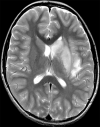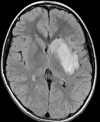Focal Cerebral Arteriopathy in a Pediatric Patient with COVID-19
- PMID: 32484418
- PMCID: PMC7587294
- DOI: 10.1148/radiol.2020202197
Focal Cerebral Arteriopathy in a Pediatric Patient with COVID-19
Abstract
We present a case of focal cerebral arteriopathy and ischemic stroke in a pediatric patient with coronavirus disease 2019 who presented with seizure, right hemiparesis, and dysarthria with positive findings for severe acute respiratory syndrome coronavirus 2 from nasopharyngeal swab and cerebral spinal fluid.
Figures




References
-
- Mahase E. Covid-19: concerns grow over inflammatory syndrome emerging in children. BMJ 2020;369:m1710. - PubMed
Publication types
MeSH terms
LinkOut - more resources
Full Text Sources
Medical

